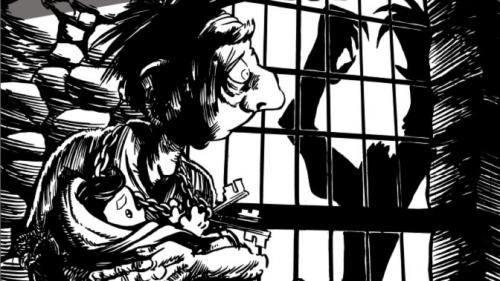With the close of my recent Iron Kingdoms campaign and the start of Dan’s Serenity Game, I’ve had a lot more free time to fritter away online instead of doing game prep. One of the fruits of this newfound spare time was the discovery of My Life with Master, a dark little RPG by Paul Czege. MLwM uses a light sprinkling of rules and a heavy slab of genre assumptions to build a storytelling framework that is a departure from your typical Dungeons & Dragons, Palladium, or GURPs fare.
The setting of My Life with Master is a remote town in central Europe some time around the year 1805. Science and Reason are on the ascent in the civilized world; but fear, uncertainty, doubt, and superstition linger in the zeitgeist. The primary antagonist is always the Master, a character created by collaboration between the game master and the players. The Master is primarily defined by his what he needs from the town folk and what he wants in regards to The Others. The particulars of all this vary according to the imagination and agreement of the play group. The Others are some person or group that the Master does not dominate, and the Master’s wants revolve around his relationship with them. My Life with Master uses several examples to illustrate this, the most clear-cut being how Doctor Frankenstein desperately wants the respect and approval of the scientific community. To satisfy the Master’s needs and the pursue his wants, the Master has a number of minions, each with a role in his schemes.
The minions are a pathetic bunch, really. These are the hapless, lonely, much-abused henchlings of a terrible power. The minions are motivated almost entirely by fear (of the Master), self-loathing, and a desire to belong; to be loved. The Master tasks them with horrible deeds, cowing them with fear and manipulating them with feigned intimacy. Eventually, through sincere contact with the townspeople, one of the minions will eventually break from the Master’s control, asserting himself and ending the reign of terror.
Unlike most RPGs I’ve been exposed to, My Life with Master has a definitive end-point. From the moment the Master is created, he is doomed to never achieve his wants, and is assured to be destroyed by one of the minions upon which he relies for his needs. Also unlike most RPGs I’ve been exposed to, with Paranoia as the most notable exception, the players aren’t expected to act as a coherent group working towards a common goal. The Master can be expected to set his minions against each other as their ties to the townspeople grow too strong, but in the long-term it’s in vain. The Master will die.
The game mechanics revolve around a very small number of numeric factors. The setting itself has ratings of Fear and Reason. Each minion has his own Self-Loathing, Weariness, and Love. By various combinations of these numbers (e.g., the Master rolls Fear plus Self-Loathing to compel a minion to perform a task; the minion roll Love minus Weariness to refuse) you determine how many four-sided dice are to be rolled. Adding the total value of the die rolls (ignoring all 4’s), whoever rolls higher gets his way. This is done on a per-scene basis, with scenes rotating amongst the players. One scene, one roll. Simple.
Due to the collaborative manner in which the Master and his minions are created, there seems to be ample opportunity for everybody to get a little of what they’re looking for, and the one-roll-per-scene dice mechanics fairly well assure that a game session won’t bog down into a tedious slog of number-crunching. If the Master ordered you to go kill the town cooper, you frame the scene, roll the dice, and describe the outcome. Yeah, you strangled the heck out of him. As you slog back to the Master’s demesne, you can hear his bereaved wife wailing at the injustice of the world trailing off into the distance. Add one to your current Self-Loathing.
I’ve been enjoying my stint as a player instead of GM, so I don’t expect to break this game out any time soon, but it’ll be waiting there on the back-burner, ready to pounce on the first sign of GM fatigue.
